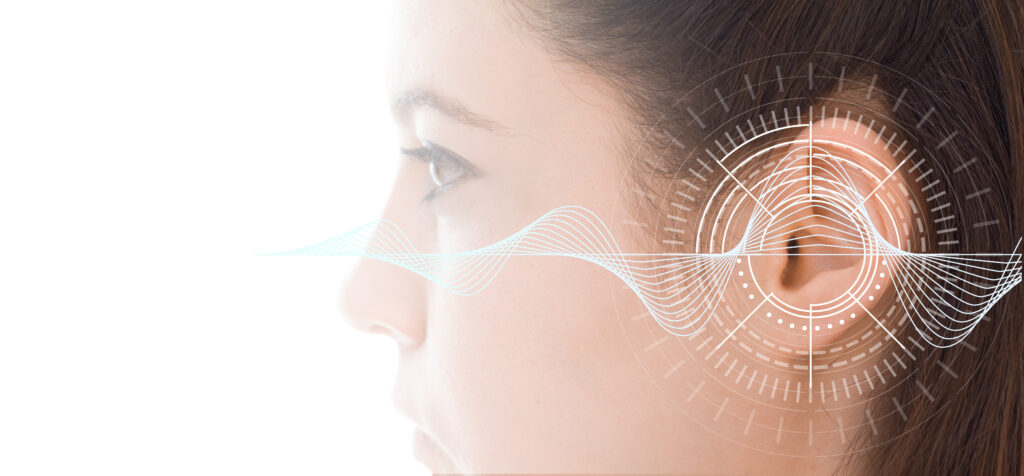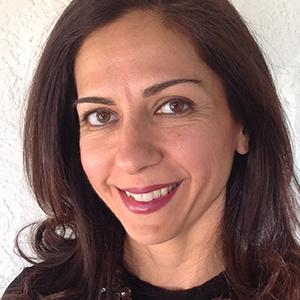Five Things to Know About Hearing Loss
with Maryam Salehomoum, Ph.D.
Senior Scholar-in-Residence
Communication Sciences and Disorders

As told to Melissa Russell
As a speech language pathologist, Maryam Salehomoum specializes in deafness and literacy development—shedding light on the complexities of communication, culture, and cognitive health.
The intersection of language and cultural diversity has always been front of mind for Salehomoum. A native speaker of Farsi, she learned French while attending a bilingual school in Iran. When revolution came, followed by war with Iraq, she began studying English, and a subsequent move to the U.S. dropped her into a full immersion of American culture. She began to understand the fluidity and diversity of language, and she valued the freedom to choose her identity, particularly when it came to language and communication.

As an undergraduate at California State University–Long Beach, Salehomoum knew she wanted a career working with people. She considered social work, but decided it wasn’t the right path. Then someone suggested speech pathology, and she never looked back. The field, which studies and works with speech and language issues, gave her an opportunity to work with people throughout their entire lives.
Since receiving her P.hD. in special education from University of California-Berkeley, Salehomoum has focused much of her research and clinical practice on youth and adolescents. However, having also worked with adults with hearing loss, she is keenly aware that they are less likely to get the services they need, including counseling about communication strategies, auditory training, and use of technology.
Additionally, given her long-held interests in language and culture, she is drawn to the study of deafness and Deaf culture—two distinct concepts, as she explains in this installment of our occasional “Five Things to Know” series.
1. There is a difference between Deaf and deaf.
While people with hearing loss or reduced hearing (also referred to as deaf or hard-of-hearing people) come from all cultures, races, ethnicities and backgrounds, only a segment identify as culturally Deaf — typically those who use American Sign Language as their primary form of communication and feel connected to a community of shared beliefs, behaviors, social organizations, and ways of life. In the Deaf community, which can include hearing people born to Deaf parents, as well as those with profound hearing loss from a young age, deafness is considered a “difference” rather than a “deficit” that needs to be fixed.
Those with later onset hearing loss, or who do not use ASL to communicate, in general do not consider themselves to be culturally Deaf, and think of deafness as a degree of hearing loss.
2. People often place their hearing at risk in ways that they don’t realize.
The most prevalent form of hearing loss is a natural result of aging. However, loss can also be caused by exposure to an intense sound all at once, such as a firearm discharging close to an ear, or repeated exposure over a long period of time, such as working in a noisy environment or repeated use of high-volume personal listening devices. The risk isn’t just related to loudness, but also the frequency with which the person is exposed to the sound – for example, regular exposure to something as seemingly safe as driving with the window down. Salehomoum recalls ringing in her ears, or tinnitus, after attending a rock concert, which went away after a few hours, but people in an environment with constant noise exposure are at risk for permanent hearing loss and tinnitus.
Age-related hearing loss, known as presbycusis, is due to the natural degeneration of hair cells in the inner ear, and risk goes up every decade after age 60, Salehomoum said. Early signs, such as turning up the television to a level uncomfortable for other family members, or asking people to repeat themselves more often, are an indication that hearing loss is occurring.
3. Hearing loss impacts more than communication.
People often underestimate the impacts of hearing loss, and society in general does not have proper education about it. When adults experience hearing loss, the greatest impacts are on communication, which can in turn result in isolation, depression, and cognitive decline, including dementia; especially when the loss is left untreated for a long period of time.
When hearing loss becomes more problematic, people sometimes withdraw from certain social gatherings they know will be difficult– where there will be lots of people and lots of background noise. This is concerning, Salehomoum says, because social withdrawal is associated with a lower quality of life.
Untreated hearing loss can also lead to a higher risk of cognitive decline over years. Severe hearing loss impacts brain processing because the person has to work harder to make sense of what others are saying. Just trying to make sense of a conversation – determining who is talking and what direction a voice is coming from – affects brain processing.
4. Communication strategies only go so far.
One of the unfortunate realities for people with hearing loss or deafness is that even when they advocate for themselves—asking friends and family members to face them and speak slowly and clearly—they don’t always get compliance. It is difficult to expect hearing people to slow down and be thoughtful when communicating, particularly at gatherings where many people are talking, often over each other. Even with professionals working with deaf or hard-of-hearing clients, when solutions are presumably simple, the person with hearing loss might not feel comfortable advocating for themselves, or even acknowledging that they have lost hearing.
5. Technology is offering better and better solutions.
For many years, hearing aids were the most common technological response to hearing loss. In the 1980s, cochlear implants—containing a microphone, processor, and transmitter that sends signals to the auditory nerve—were introduced for profoundly deaf young children with bilateral loss (both ears). Subsequent improvements in that technology enabled it to help children and adults with less severe hearing loss and, more recently, hearing loss in only one ear.
Additionally, digital modulation systems are available to amplify speakers in public spaces, such as theaters and classrooms. The Roger pen, a slim wireless microphone, delivers loud and clear speech through noise and over distance to aid those with hearing loss. Captioning is also a boon, Salehomoum said, and is available everywhere from Facetime to Zoom meetings. And of course, text messaging was a game changer for everyone with a mobile phone.
Bonus: Prevention is key.
While some degree of hearing loss can be expected through the aging process, Salehomoum advises being proactive—keep the ear buds at a low volume, use ear plugs in noisy environments, and get hearing checked if any loss or change in hearing is suspected. Unchecked hearing loss will likely progress and will, at some point, certainly impact day-to-day life.
Categories